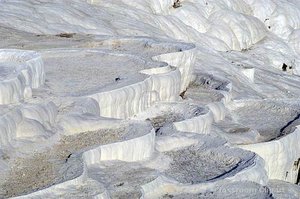Limestone
|
|
| Contents |
Limestone: The Rock That Builds and Shapes the Earth
Limestone is a type of sedimentary rock that forms mainly from the remains of tiny sea creatures. These organisms produce shells made of calcite, or calcium carbonate (CaCO₃). Over time, the shells settle to the ocean floor, pile up, and slowly turn into rock. Limestone plays an important role in Earthís history, landscapes, and human construction.
What Is Limestone Made Of?
Limestone is made mostly of the mineral calcite. The calcite usually comes from the hard shells of marine organisms like plankton, clams, and corals. These shells fall to the ocean floor and collect over millions of years. The pressure from layers above slowly compacts the materials into rock. This deep-sea sediment is known as pelagic ooze.
Besides shells, other materials can mix into limestone:
- Clay
- Sand
- Iron oxide (which gives red or brown color)
- Organic material (from plants and animals)
These impurities give limestone different colors and textures. While pure limestone is usually white, the presence of other materials can make it gray, yellow, or even pink.
Types and Forms of Limestone
Limestone can form in several ways and appears in many different textures:
Crystalline Limestone
Has large, visible crystals of calcite. Often formed from secondary precipitation, when groundwater (especially rainwater that has soaked into the ground) becomes full of calcite and deposits it in caves.
Granular Limestone
Made of small, grainy particles. A common example is oolitic limestone, which contains small round grains called oolites.
Clastic Limestone
Contains fragments of older rocks and shells.
Dense or Massive Limestone
Lacks visible grains or crystals and appears smooth and solid.
Special Varieties of Limestone
Travertine
Travertine forms near hot springs, cold springs, or waterfalls. As the water evaporates, it leaves behind bands of calcium carbonate. Travertine is popular for building and decorating because of its smooth surface and color variety. Tufa
Tufa is a soft, spongy version of travertine. It often forms around waterfalls and has a light, airy appearance.
Limestone in the Landscape
Limestone can shape entire landscapes. Areas made mostly of limestone often have a unique look called karst topography. This includes:
- Caves
- Sinkholes
- Underground rivers
Water thatís slightly acidic can dissolve limestone, creating these features. Over thousands of years, this leads to the formation of dramatic landscapes. Famous Limestone Locations
- Malham Cove, England
- Verdon Gorge, France
- Ha Long Bay, Vietnam
These places are known for their stunning limestone cliffs and rocky formations.
Uses of Limestone
Limestone is incredibly useful and has been used by humans for thousands of years. Here are some of its main uses: Construction
Limestone is a key material in:
- Buildings (especially in older architecture)
- Roadbeds
- Landscaping
- Cement (used in concrete)
It is easy to shape, long-lasting, and beautiful. Thatís why many historical buildings like banks, train stations, and monuments are made from limestone.
In modern buildings, limestone is often used as a thin facade (a covering layer) rather than as solid blocks, because it's heavy and expensive. Limestone from Indiana
In North America, most building limestone comes from Indiana, which has large, high-quality quarries. Environmental Effects
Even though limestone is strong, itís vulnerable to acid. This means acid rain can damage buildings and statues made of limestone. Acidic water reacts with the calcium carbonate, slowly wearing away details and surfaces. Soil Formation
Limestone is a parent material for a type of rich, fertile soil called Mollisols. These soils are often found in grasslands and are very good for farming.
Interesting Facts About Limestone
- Limestone makes up about 10% of all sedimentary rocks on Earth.
- Some of the worldís oldest and most famous buildings, like the Great Pyramid of Giza, are made of limestone.
- Chalk, a soft white limestone, is used in classrooms and was once a major writing tool.
- Limestone contains fossils, which help scientists learn about ancient marine life.
- The White Cliffs of Dover in England are made almost entirely of chalk, a type of limestone.


